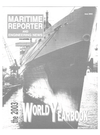
Page 18: of Maritime Reporter Magazine (June 2003)
Read this page in Pdf, Flash or Html5 edition of June 2003 Maritime Reporter Magazine
Government Update
AIS - Panacea or Pandora's Box
By Dennis Bryant, senior maritime counsel, Holland & Knight,
Washington, D.C.
According to Greek legend, Zeus had the messenger god Mercury leave a mysterious box with Pandora. Mercury told Pandora to hold the box for safe- keeping, but under no circumstances was she to open it. Not long after
Mercury departed, curiosity got the bet- ter of Pandora and she opened the box to examine its contents. Unfortunately, the box contained all the ills and misfor- tunes of the world. They promptly escaped and have been loose in the world since that time.
The word 'panacea' is derived from the
Greek terms "pan" (meaning all) and "akos" (meaning remedy). According to the Merriam-Webster Dictionary, the word means "a remedy for all ills or dif- ficulties."
The question is which term applies to
AIS?
What is AIS?
AIS is an electronic transceiver unit intended to be integrated with a ship's radar, gyrocompass, global positioning system (GPS), and other operational and navigational systems. When fully oper- ational and when functioning properly, it will provide the officer in charge of the navigational watch with a radar display that includes a mark for every signifi- cant ship within radio range, each with a velocity vector indicating speed and heading. Each ship 'mark' could reflect the actual size of the ship and its posi- tion with GPS or differential GPS accu- racy. By clicking on a ship mark, the officer could learn the ship name, course, speed, classification, call sign, registration number and other informa- tion. Maneuvering information, closest point of approach (CPA), time to closest point of approach (TCPA), and other navigation information could also be available.
AIS operates in the VHF maritime radio band. It is capable of handling more than 4,500 reports / min., and updates itself as often as every two sec- onds. It uses Self-Organizing Time
Division Multiple Access (SOTDMA) technology.
Each AIS system consists of one VHF transmitter, two VHF SOTDMA receivers, one VHF digital selective calling (DSC) receiver, and a standard marine electronic communications link to the shipboard display and sensor sys- tems. Position and timing information is normally derived from a GPS receiver and generally includes a medium fre- quency differential GPS receiver. Other information broadcast by the AIS is obtained electronically from shipboard equipment through standard marine data connections. Heading information and course, and speed over ground would be
Dennis L. Bryant, Senior Maritime
Counsel at the law firm of Holland & Knight, Washington, D.C., is a contributing editor of MR/EN. provided by all AlS-equipped ships.
Other information, such as rate of turn, angle of heel, pitch and roll, destination, and ETA, could also be provided.
The AIS transponder works in an autonomous and continuous mode, regardless of whether the ship is on the high seas or in pilotage waters. System coverage range is similar to other VHF applications. Propagation is slightly 16" Marine Hose
Short Spool Piece
CL Coupling
Real Time-Saver.
MMC C-L couplings promise you high-speed hook up: the fastest, safest possible flanged connections for a wide array of applications such as hoses, manifolds and loading arms, etc. Result: vibration-proof, leak-proof, twist- proof connections every time.
MMC International Corp.
Inwood, New York USA • 1-800-645-7339
Fax:516-371-3134 • Web: www.mmcintl.com • E-mail: [email protected]
MMC (Europe) Ltd. • Fax:(01670)738789 • E-mail: [email protected]
Circle 296 on Reader Service Card 18 Maritime Reporter & Engineering News

 17
17

 19
19
